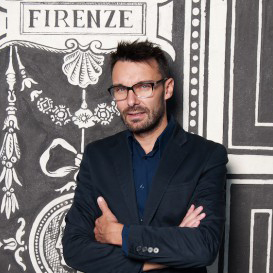So my shift from an urban to a rural setting is effectively a countermovement, sociologically speaking, although there are also others who return to the countryside, some permanently, some for a period. Stefan Sagmeister is one of the latter. He was born in Bregenz, capital of the province. Every seven years, he takes a year off from his work as a graphic designer, and this time he has chosen to spend a part of it in the Bregenzerwald, contemplating concepts of beauty. Without a doubt, it’s a great place to do just that. The landscape, the traditional and contemporary interpretations of architecture and craftsmanship, the region’s culinary specialties (which are not limited to Käsknöp e, the famous local fare comprising of tiny dumplings covered in a hearty mix of melted cheese and roasted onions), to name a few. Similarly, back in the 18th century, Swiss Neo-classical painter Angelika Kaufmann, who also had family ties in the Bregenzerwald, spent a season in Schwarzenberg, a village in the heart of the valley.
Last summer, Sagmeister offered a glimpse into his concept of the world when he gave a talk at FAQ Bregenzerwald, a several-day symposium/festival, on how to tap into the potential for spending our lives in a good and meaningful way. Interestingly – or rather, understandably – the event took place in the quite secluded Bregenzerwald. Creative minds and thinkers from all fields: chefs, athletes, and many more, were invited to give their take on questions like Was everything better in former times? / Failure, or an opportunity to begin again? / Are we allowed to be happy? And, together with the attending guests, they hiked in the mountains and visited inspiring places in nature. Instead of finding definitive answers to these questions, they just appreciated the opportunity to spend good times with likeminded people. Friendship, the makers behind FAQ, are a group of creatives, some of whom have family roots in the valley but have spent many years abroad or travelled the world. They are now looking for “the potential for a good life” that can be found in the rural but adopted anywhere.
Helpless romantics? Utopians reacting to an overwhelming, alienating world? You could say so. Well, maybe I am one of them. Now and then I actually do feel like William Guest, the main character in Arts and Crafts pioneer William Morris’s social utopia, as presented in his novel News from Nowhere. When in the early morning I leave for work from my new home just below the timberline, I sometimes think to my sleepy self, Am I dreaming or living a dream?
So, what do you do for work in a place like this? Ideally, you’re a craftsperson. A strong number of whom emerged from the agricultural society in the valley, their endeavours occasionally reaching industrial dimensions. The world market leader in wire hangers, for example, is an inventive metalworker from the region, and there are more of his kind around here. The people who want to stick with manual production and – simply put – remain independent yet united in their battle against globalisation, established Werkraum Bregenzerwald in 1999.
Today, the collective comprises about 90 crafts enterprises – carpenters, cabinet- makers, plumbers, painters, butchers, florists, tailors, and many others. All of them agree to high quality standards and hold to the conviction that prices have to be fair and provide a reasonable income. And they have realised this vision. Order books are full; they have their own Werkraum Haus, a place for exhibitions and events designed by Pritzker Prize winner Peter Zumthor. They also have Werkraum Schule, a new vocational school for budding craftspeople, developed to attract and promote young talent, and there is the triennial Handwerk + Form, an international competition for craftspeople, designers, and architects. All this hasn’t gone unnoticed by UNESCO, either, which recently added the Werkraum to their list of Good Safeguarding Practices of the Intangible Cultural Heritage.
William Morris would be delighted to witness this, even though the Werkraum community might not share his Marxist views. At least, not deliberately. Still, common welfare through craftsmanship in agricultural surroundings has a long-standing tradition in this region. Did the Bregenzerwald inspire Morris’s fictional socialist novel? According to a local legend, Morris was the architect of Villa Maund, a hunting lodge built for an English industrialist and banker in the 19th century in a remote part of the Bregenzerwald. Anyway, if he ever did set foot in the valley, he surely would have taken a liking to his contemporary, local hero Franz Michael Felder (1839-69). Still today, the social reformer, writer, and farmer is very much honoured in the region. “I came alive again and became one of the most active members of this respectable society. This is where I tried to free myself from several burdens by making the people a commons”, he once wrote. Today, the quote graces the sides of a negotiating table made by Werkraum carpenter Markus Faißt, reminding the men and women sitting around it to guide the community in the right direction.
Yes, I really do live here now!
Thomas Geisler is a designer, curator, and author. In 2016 he was appointed managing director of Werkraum Bregenzerwald. Prior to this, he headed and curated the Design Collection at MAK (Museum of Applied Arts / Contemporary Art) in Vienna. Geisler is also a co-founder of VIENNA DESIGN WEEK and has curated projects for the Vienna Biennale and the London Design Biennale.

